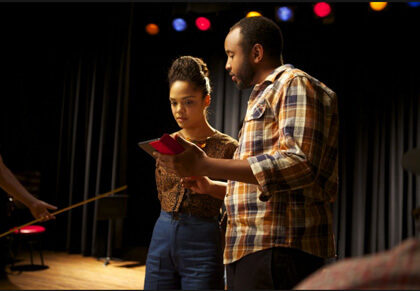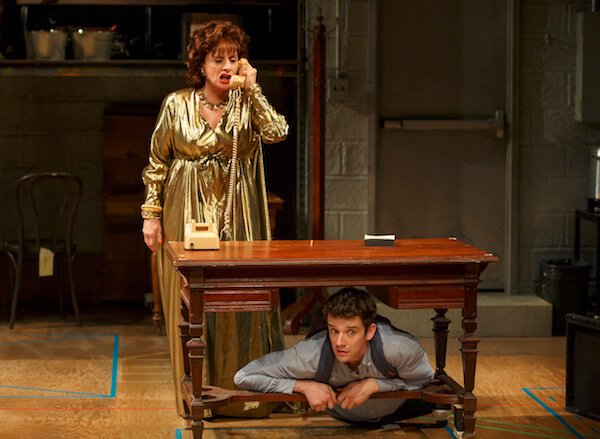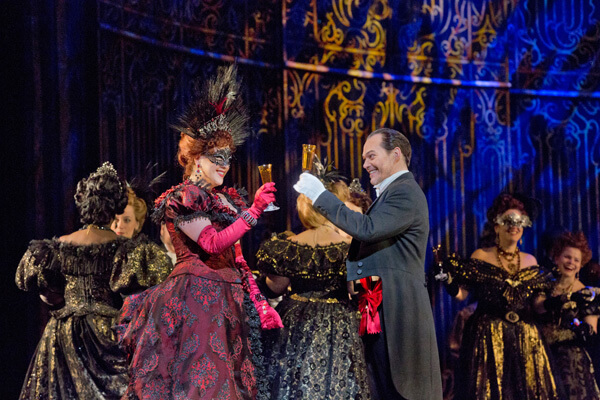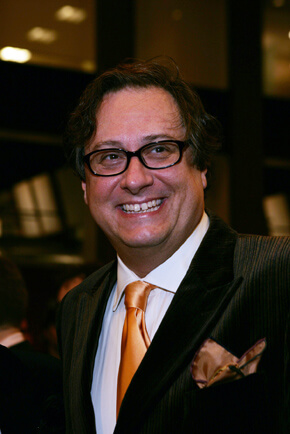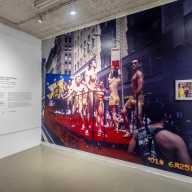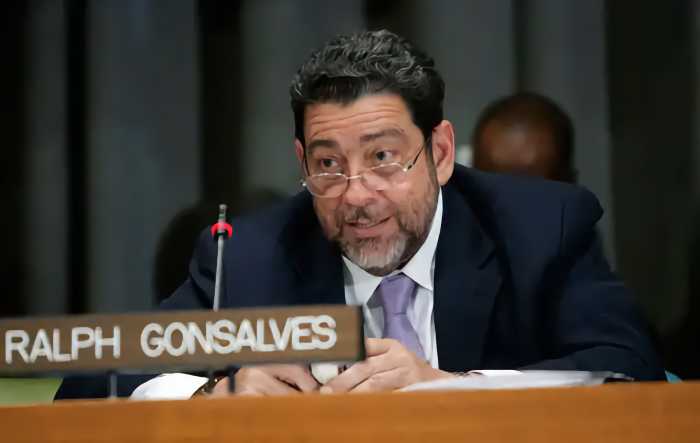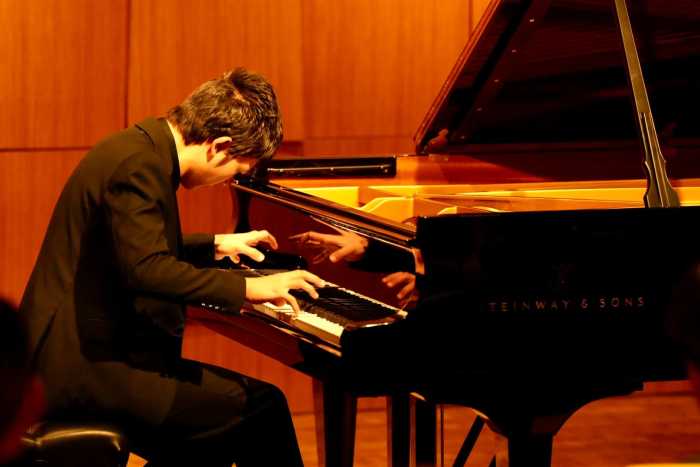Tony Sheldon, Tony-nominated for Priscilla, Queen of the Desert,” appears in the Encores! production of “The Band Wagon.” | BONEAU/ BRYAN-BROWN
Broadway’s “Priscilla, Queen of the Desert” was largely a glitzy piece of utterly commercial jukebox fluff, but when Tony Sheldon appeared as Bernadette, the veteran drag queen on a very personal mission, the theater’s temperature changed. For here was the real thing, a brilliant actor, fully possessed of an innate gravitas and shining charisma, making what could easily have been a flamboyant cartoon into a flesh and blood character, deeply glamorous, steeped in a rich and vivid past.
He won a deserved 2011 Tony nomination, but, since then, scandalously, has been pretty much off the New York stage, although quite active regionally in shows like “Hello, Dolly!,” “My Fair Lady,” and “Camelot.” So it was with particular pleasure that I read of his replacing Roger Rees in the upcoming Encores! presentation of “The Band Wagon” (Nov. 6-16, New York City Center, 131 W. 55th St.; nycitycenter.org). The show is adapted from the 1953 MGM film — directed by Vincente Minnelli with a dazzling catalogue of songs by Howard Dietz and Arthur Schwartz and a script from Betty Comden and Adolph Green — that ranks high on everyone’s list of greatest movie musicals, a terrifically witty peek into Broadway backstage and the process of putting on a show.
The elegant, chummy Sheldon, who’s brought such a touch of class to the theater’s gay community, took a break from rehearsals and told me, “All I know is that Roger Rees took sick and was in the hospital on Friday, and they called me that day to ask if I could learn the part of Jeffrey Cordova [originated by the priceless Jack Buchanan]. He’s very much based on José Ferrer, the multi-tasking actor/ director/ entrepreneur, at the time when he was directing five shows in one season, starring in both ‘Richard III’ and ‘Charley’s Aunt,’ and understudying an actor in another production. Even in somebody’s living room, he’s always on and directing people, shifting them around. In the script, he’s English, so I can’t do a direct impersonation of Ferrer, but, in my first scene, he’s playing ‘Hamlet,’ and is at full throttle the entire time.
Sheldon back on the boards, brilliant “Dear White People,” Hawks & Welles masterpieces
“Douglas Carter Beane has changed the script and other Dietz and Schwartz songs, like ‘Something to Remember You By,’ have been added. Laura Osnes is playing a singer rather than the dancer Cyd Charisse was in the film, so she’s been given more numbers, like ‘Triplets’ with me and Brian Stokes Mitchell, in the Fred Astaire role.
“They’ve beefed up Nanette Fabray’s old role for Tracey Ullman, with more scenes between her and Michael McKean as her husband. Beane has her now carrying something of a torch for Stokes and, now that she’s back in his orbit, McKean is getting jealous, with a lot more drama in the second half of the show. Comden and Green actually once told our director/ choreographer Kathleen Marshall that their MGM contract ran out while they were writing the film and they straightaway went to work on the show ‘Wonderful Town.’ That’s why there’s suddenly no story in the movie and all of these numbers.
“They asked the costume designer [Mary Ann Nyberg] if she could design a costume for Cyd for the finale that looks as if she’s going to wind up with Astaire. They wanted the costume to do all the work because there was no scene, so the dress was all glamour and flowers to show that they’re going to get married.”
Sheldon is excited to be really trodding the New York boards again: “This is the first high profile gig I’ve had in New York since ‘Priscilla.’ So to have such a wonderful showy role is ideal and going to hopefully save me a lot of knocking on casting agents’ doors. Once you’re in a dress, people lock into that image of you, so it hasn’t been easy being seen by casting directors. They say, ‘Oh, yes, we know what he does,’ and there are so many other people available.
“I don’t mean to discount ‘Priscilla,’ which was a total life changer for me and got me out of Australia. My aunt, Helen Reddy, and my mother, Toni Lamond, who was an Australian musical hall star, were living in Los Angeles, and they said, ‘Come over here and become an American citizen!’ I kept saying, ‘No, I’m actually getting the dramatic roles I want in Australia [Shakespeare, Pinter, Chekhov] and quite happy with my career.’ But to actually be brought to Broadway in a role that was created on me was a gift and I couldn’t have asked for a better intro.”
Sheldon started with the first “Priscilla” workshop, which took five years to get to Broadway, and was never daunted by stepping into Terence Stamp’s high heels in the role.
“I looked at the film again when I got the role and thought, ‘He’s playing it very glum.’ I read in an interview where he said he wanted to portray the pain of somebody trapped in the wrong body. I’ve hung out with a lot of Australian drag artists and the character of Bernadette had been a star at Les Girls, a very glamorous nightclub in Sydney, and at the height of her stardom was living the high life of jewels, furs, and parties all night long. So this woman is not walking around like a wet weekend.
“That gave me the freedom to go my own direction. The designers brought all of Terence’s costumes on a rack and were going to put me in them. But he’s built like a pencil and I was more Rubens-esque at the time. They said, ‘We’re going to turn you into Rita Hayworth, an entire new tack, with leopard skin and big hats! It always used to irk me when I’d read on the dreaded message boards, ‘Oh, he’s just doing Terence Stamp’s performance!’ Pay attention people!”
When the show got to England, the creators lost confidence in it and took out almost all of the Australian references.
“The script was filled with English pop culture references I didn’t even know, at one point even having Queen Elizabeth come on stage with a corgi. I did have to say to them, ‘We’ve got to have the courage of our convictions. Let’s not pander to our non-Australian audiences.’ When we came to Broadway, we had a little more courage, although our producers did insist on having Jerry Mitchell on the payroll as our consultant and David Thompson as a new book writer. A lot of their stuff didn’t end up in the show, and by the time we opened, we decided to just risk it and go with pretty much what we had in Australia.
“Bette Midler was brought in as a producer in Toronto, but we never saw her. She wasn’t hands-on but there was her name above the title and I guess she had a lot of money in it. We were introduced to her, but she wasn’t hanging about, drinking tequila slammers with us.”
Sheldon’s Tony night was something less than glamorous: “I knew I didn’t have a snowball’s chance of winning. We were following ‘Hairspray’ and Douglas Hodge in ‘La Cage aux Folles,’ and I thought, ‘They’re not going to go three times for a man in a dress,’ plus our competition, Norbert Butz and ‘The Book of Mormon’ boys, was stiff.
“Suddenly, they said, ‘You’re performing on the Tony show and your category is being called out straight after your number.’ I asked, ‘Can I just stand in the wings looking gracious in my frock because I’m not going to win?’ ‘No! You have to get back into your dinner suit and seat, and you have four minutes during the commercial break to do it.’ So Tony night became about me having to change fast, and they made me rehearse it over and over during the day. I was standing there with a stopwatch while they got the makeup off me, and then I was running down flights of stairs to be in my seat so they could say, ‘Tony Sheldon in Priscilla…’ with me, smiling and nodding in my dinner suit. And it was, ‘No, no, no! He was 30 seconds late! Put all that makeup back on him and we’ll do it again!’
“I wanted to be enjoying this but it was all about that moment. The wonderful thing was, as I was arriving for the red carpet, Beth Leavel saw my deer-in-the-headlights expression and just took my hand, saying, ‘I will walk you through this,’ and she calmed me down. She said, ‘The first nomination is always the worst. When you get your second, you will enjoy it!’ What a wonderful thing to even think a second nomination was a possibility in my future, and so kind. An extraordinary thing happens when you know you’re not going to win. You sort of get depressed with the nomination, a strange feeling of unworthiness and not belonging up there in this exalted company. Tony season is four weeks where you’re just doing press, and I was also nominated by the Drama Desk and League, the Outer Critics, and actually did win a Theater World Award. So every day, while you’re performing, you have to dress up and you’re glad-handing, and I was just crying non-stop. I’ve seen it happen to other people subsequently and been able to warn them, ‘Be prepared because you’re going to go into some weird spiral, so try to be as positive as possible.’”
Sheldon has never had a problem being identified publicly as a gay man.
“Oh, yes, always out! I used to alarm people when I was 17, doing interviews and the press would ask, ‘What role would you most like to play?,’ and I’d say, ‘Anita in “West Side Story.”’ Press agents were constantly begging, ‘Please don’t say things like this. You’re supposed to be a young butch Aussie!’
“I find that people here just don’t care. It wasn’t quite so in television in Australia: one very handsome leading man of a cop show came out and went right back in four weeks later. It backfired on him, so he just shut up after that. Australia is not the tolerant society people imagine. We do have the big Mardi Gras every year, but then it’s sort of, ‘Shut up and get on with it!’ But it seems a waste of time to be hiding and I’ve been with my partner for 35 years. He’s another actor in Australia, Tony Taylor, and my mother was named Toni, so we’re everywhere you look!”
Director Justin Simien on the set of “Dear White People” with Tessa Thompson. | ROADSIDE ATTRACTIONS
The best new film you can see right now is Justin Simien’s blisteringly smart, funny, daring, and incisive “Dear White People,’ which concerns a demonstration by black students at an elite university over a racist-themed party at one of the residences. It’s one of the very best films ever made about the college experience and accomplishes everything Spike Lee’s clumsy, homophobic “School Daze” tried to do.
I moderated a spirited Q&A on its opening night at the Regal Union Square on October 17, with its gorgeous, talented star Tessa Thompson, and it was really inspiring to see how deeply the movie affected the smart, passionate audience. Thompson described how she went on a mission for the role of Sam — one of the great, surely the smartest, embattled American film heroine — the moment she read the script. Inspired by Lisa Bonet’s iconic presence on “The Cosby Show,” she haunted Etsy and other vintage venues to put together her fabulously eclectic wardrobe.
Film Forum is reviving two of my favorite films. Howard Hawks’ exhilaratingly gallant “Only Angels Have Wings” (1939) is one of his very best investigations of men seriously at work (air mail carriers, here) and how that bonds them, both professionally and emotionally (Nov. 7-13,209 W. Houston St.; filmforum.org) . Cary Grant, full of romantic diffidence and sexy swagger, even garbed in a wide Panama hat, bomber jacket, a couple of low-slung belts, baggy flood-tide linen pants, and boots, and squeaky Jean Arthur, enchantingly goofy and lovelorn for him, share a magically rocky chemistry while demonstrating exactly what made them such huge stars and so enduring today.
Grant’s ragtag crew — Allyn Joslyn, Sig Ruman, Don Barry, John Carroll and, especially, Thomas Mitchell, as cryptic in his love for Grant as Arthur is blatant — are deeply funny and lovable. Rita Hayworth smolders effectively for the first time on screen as a delicately determined vamp. (Trivia: Arthur’s bathrobe is the same one Katharine Hepburn wore in “Holiday” the year before; Arthur liked it so much, she thought designing a new one was totally unnecessary.)
Orson Welles’ “Touch of Evil” (1958) is simply a wonder, and one of the very greatest film noirs (Oct. 31-Nov. 6, 209 W. Houston St.; filmforum.org). From its insanely virtuosic one-take beginning that culminates in an explosive car bomb, Welles holds you tight in his masterful grip comprised of sheer technical brilliance, deliciously black humor, and suspenseful South of the Border terror. Abetting him is one of the most fabulously perverse casts ever assembled: Mercedes McCambridge as the butchest of butch dykes on bikes (anticipating a gang rape, she mutters, “I wanna watch”), stutteringly eruptive Akim Tamiroff, hilariously geeky Dennis Weaver, Zsa Zsa Gabor, Marlene Dietrich (as a Mexican fortune-teller who’s seen everything, twice), and Welles himself, as an insanely fat, insanely corrupt sheriff. Even Janet Leigh and Charlton Heston, usually the epitome of bland and wooden, respectively, are here jolted into behaving like real, complex, and sensual human beings.
I wish Molly Ringwald had actually talked more than sung at her recent Cafe Carlyle engagement (October 7), as I would have much preferred hearing any story about her storied career as Hollywood’s Golden Girl during the 1980s Brat Pack era than her faltering vocals, which did no justice to the evergreen standards she selected. But there was nary a mention of “Sixteen Candles,” “The Breakfast Club,” or “Pretty in Pink,” although she did encore with a revamped, vampy “Don’t You Forget About Me.”
Buster Poindexter (aka David Johansen), who followed her engagement (October 21), more than made up for this, with a terrifically rousing show in which his wonderfully salty humor, expressively growling voice, and killer musical chops were on bravura display. It was a total party, with his to-kvell-for backup band of the ace-ist musicians in the business. His excavation of obscure blues, particularly, from recorded music’s earliest era, is always wonderfully salubrious. His ebullient wife, Mara, resplendent in vintage Versace and Kamali, told me how thrilled they both are with his resurrection of the Buster persona, after touring so long and wide with the New York Dolls. Staying at the Carlyle, of course, ain’t too shabby either.
Contact David Noh at Inthenoh@aol.com and check out his blog at http://nohway.wordpress.com.

